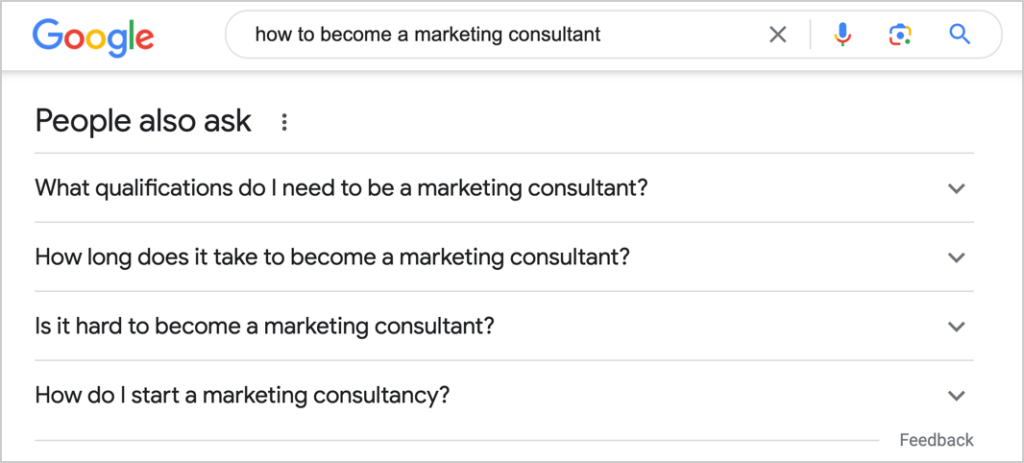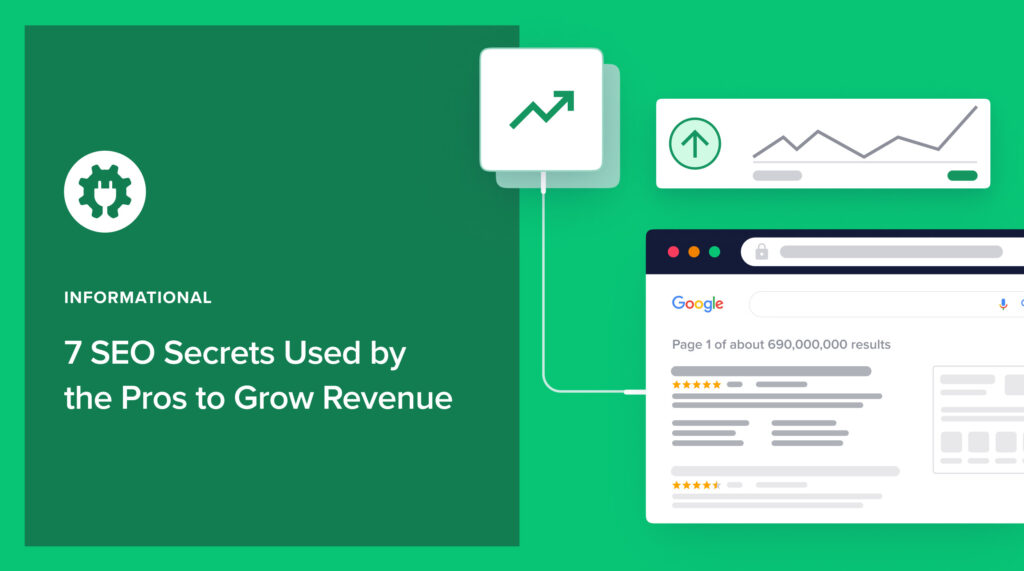Interested in learning SEO secrets that top marketing pros use to grow revenue?
Many businesses rely on content to drive conversions and sales. But what do the successful ones do differently?
In this article, you’ll learn 7 SEO secrets guiding world-class content marketing.
In This Article
#1: Produce High-Quality Content That Aligns With Search Intent
You’ve heard that selecting a target audience and creating content based on their interests is crucial.
But today, if you want to rank well, every piece of content you create needs to serve search intent for that specific topic — and do it better than top-ranking articles.
Search intent is your prospect’s motivation and mindset on a topic, revealed by search engines.
- What problems are they struggling to solve?
- What are the most pressing questions they have?
- What are the common misconceptions they have?
Google knows. And you can find out.
To get a quick idea of how this works, let’s pick a topic: “how to become a marketing consultant.”
We’ll open up Chrome in Incognito mode and search for this keyword.
Notice that the top-ranking articles are mainly step-by-step guides.

Since Google rewards the articles that best match search intent, you can conclude that what searchers expect from an article on this topic is a step-by-step guide.
Next, in the “People also ask” section, we see typical questions people have about this topic. (Clicking on a question causes the answer to be shown, and more questions appear.)

Here we get insights. Addressing some of these concerns in your article can help you satisfy readers and rank well.
Now, scroll down, and we’ll see these related keywords highlighted in gray. These are additional clues for you.

Guess what? You just did “keyword research.” (If you’re new to keyword research, check out this helpful beginner’s guide.)
One final thing to remember about keyword research; some keywords are easier to rank for than others.
Use a keyword research tool like Ubersuggest or Ahrefs that displays a rating (from easy to hard) for keywords.

Pro-tip: Choose long-tail keywords. They’re easier to rank for.
#2: Understand the Real Value of Content Marketing
Savvy brands use content to solve problems and provide opportunities for their target audience.
But marketing novices often focus on the wrong goal: views. Views don’t equal sales and revenue, though.
When you understand the value of content marketing done well, you’ll understand why you don’t need lots of views to make money.
Consider a fictitious company that has a single product that costs $500. Which article below is doing better?
| Average page views/month | Average sales/month | Dollar value/year | |
| Article 1 | 10,000 | 1 | $6,000 |
| Article 2 | 750 | 2 | $12,000 |
Article 2 is the clear winner, even though it has fewer views.
This sort of comparison is understood and acted on by successful businesses.
To the degree that you understand the problems your target audience is trying to solve and help them do that, your sales and revenue will increase.
#3: Create Content that Targets MOFU and BOFU Keywords
Not everyone on Google is ready to buy. You can separate the prospects from the tire kickers by their keywords, though.
Consider these examples: which keyword indicates the searcher is close to buying?
- Insurance
- Car insurance
- Cheap car insurance quotes
If you picked the last one, you’re catching on.
So what’s MOFU and BOFU? These are terms used to describe your target audience’s stage.
- TOFU: Top-of-the-funnel: These searchers have no commercial intent. And ranking for TOFU keywords (like “insurance” and “car insurance”) is extremely difficult. Creating TOFU content typically yields few (if any) results and wastes resources.
- MOFU: Middle-of-the-funnel: These searchers are trying to solve a problem and have some commercial intent. They are thinking about their options and might be comparing products and services. They also might be searching for “how-to” content (such as “how to fix frozen pipes”). And they use commercial keywords like “best SEO plugins” and “Geico vs Progressive.”
- BOFU: Bottom-of-the-funnel: These searchers are on the brink of buying and use transactional keywords like “book Bahamas cruise” and “best place to buy a diamond engagement ring.”
To save money and increase revenue, skip the TOFU and focus on creating content on MOFU and BOFU keywords.
#4: Create How-To Content
Ever wonder why there’s so much “how- to” content on the web?
One reason is that “how-tos” are big money-makers.
Done well, this type of content drives conversions and sales.
To create “how to” content, first figure out what problems your target audience is trying to solve or what opportunities they want.
Here are some examples that show the wide variety of “how to” content:
- (Problem) How to fix a drywall hole
- (Problem) How to improve your posture
- (Opportunity) How to improve your English
- (Opportunity) How to become a Rhodes Scholar
Keep in mind that some prospects may only have a vague idea of the problem they want to solve, while others will have a precise understanding of it.
Be sure to include your product in the “how-to” article.
#5: Create Comparison Reviews
Remember we said that your MOFU audience likes to compare products? They’re trying to figure out which is the best.
So, help them compare products. You can do this by creating your own product comparison articles.
Here are some tips we use in our own business.
- Create “versus” articles based on keywords that target your competitors’ brand names. Examples are: “Geico vs Progressive” or “Gravity Forms vs WPForms.”
- Consider including a comparison table so visitors can compare quickly. But keep it limited: too many features in a table can overwhelm viewers.
- You can also make your article a “triple versus.” Example: “PandaDoc vs Docusign vs SignHouse”

The point of triple-versus articles is to get your brand showing up in searches for your competitors. Like this.

#6: Commit to the Unsexy Fundamentals
We attribute a lot of our success to consistent, disciplined SEO.
One of the best ways to be consistent is to use a checklist. In our practice, the All in One SEO (AIOSEO) plugin serves as our checklist.
In editing mode, here’s what a WordPress page looks like with the All in One SEO (AIOSEO) settings on the right side.

Notice that there’s an overall score for the page. We routinely push that score up in 5 minutes by acting on the plugin’s recommendations.
Would you like to learn more about how this works? Check out this article.

All in One SEO (AIOSEO) is an established plugin with thousands of 5-star reviews on WordPress.org. It’s currently used by over 3 million sites.
And when you use the plugin, you’ll get access to their support team of world-class engineers.
#7: Add Internal Links
Adding internal links to your content is one of the most powerful (and overlooked) SEO tactics.
Google learns which of your pages are most important based on how many internal links are pointing to them.
Want your conversion and product pages to rank higher? Try adding more internal links to them.
Also: did you know that most newly-published articles are orphan pages? Adding 1 or more internal links to them can help them get more traffic.
We use All in One SEO’s Link Assistant, available in the Pro version, to do routine internal link-building.

Don’t underestimate the power of setting aside 15 minutes a month to add internal links to your site.
Learn more about link building.
Bonus Tips
- While you’re improving your SEO, learn how to generate leads.
- Explore using pillar articles to plan content and build your authority.
- Use our common-sense guide to create a content strategy tightly aligned with business goals.
What’s Next?
We hope this post gives you a useful overview of SEO secrets that set the pros apart from novices.
Next, explore the connection between backlinks and big money and learn how avoid SEO scams.
If you found this article helpful, then please subscribe to our YouTube Channel. You’ll find many more helpful tutorials there. You can also follow us on Twitter, LinkedIn, or Facebook to stay in the loop.
Disclosure: Our content is reader-supported. This means if you click on some of our links, then we may earn a commission. We only recommend products that we believe will add value to our readers.


Excelente. Fácil entendimento dos conceitos e aplicações. Parabéns só Team
Obrigado pelo seu comentário, Alvaro. Ficamos satisfeitos por saber que o artigo é útil para si.
Great article!
Glad it was useful Lukie. Thanks for the feedback.
Nice and informative article